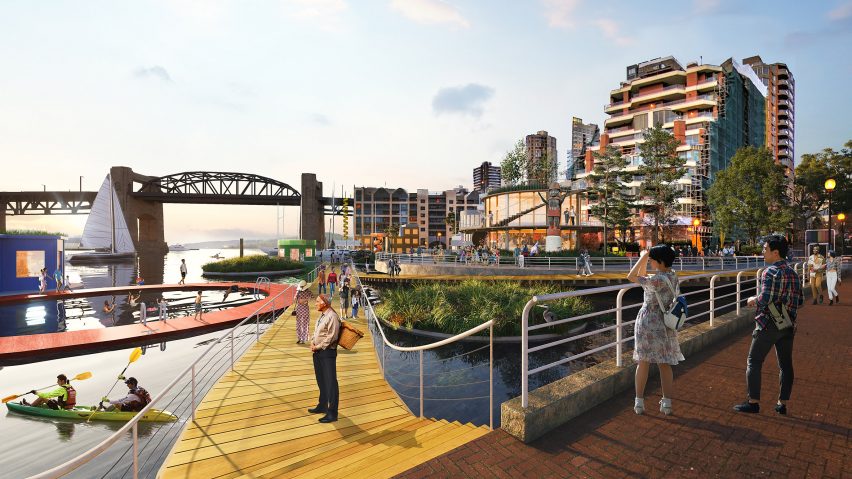Dutch architecture studio MVRDV has released a study that aims to offer possible solutions to urban planning in the face of rising sea levels by reimagining the Vancouver waterfront.
Developed as part of Vancouver’s Sea2City Challenge, Sea Level Rise Catalogue looks at methods for adapting to rising sea levels, which according to the IPCC could rise as much as two metres by 2100, posing many problems for the large population centres along the coasts.
"As sea level rise is gradual, there is time to develop and implement this change if we start now," said MVRDV in the report.
"Cities need to leverage this urgency to develop and test adaptation solutions and share knowledge globally to accelerate a prosperous, adaptive, sustainable future of our coastal communities."
The study proposes that dykes and walls blocking the water level will no longer be viable options for our cities and that other approaches must be taken.
It also challenges the language traditionally used around infrastructure in the face of changing climates, asking readers to use "reciprocal" language such as "protect", "host", and "restore" as opposed to "nature-detached" perspectives like "resist", "accommodate", and "retreat".
Solutions for the problem range from adapting preexisting structures using stilts, changing building programs, making evacuation routes and upgrading utilities like pumps as well as more intensive solutions such as tearing down buildings and constructing others on top of the water.
Cities are important organisms
"It's always about the transect of the city to the water and how the water systems will change over time," MVRDV associate architect Kristina Knauf told Dezeen. "It will be a good combination of retreat, protect and adapt."
"We realize that the existing cities are important organisms for us. It's not as simple to just say 'let's move away'," she said.
"Sometimes you actually move towards the water because there are certain urban functions that you need to allocate to these places."
Taking Vancouver as a test case for what the studio believes is a universal problem, the catalogue reimagined the waterfront along False Creek, an inlet that cuts through the city.
They stipulated that the call for resilient architecture should include principals of "rewilding" and worked closely with the city to implement a vision for the next 100 years of the creek.
Indigenous people learned how to live with the water
By using the data gathered about the urban makeup of the waterfront, MVRDV developed a series of pilot structures that utilise the principles of the catalogue.
Community inclusion was a significant aspect of these proposals, and the studio consulted local groups, especially advisors from the local First Nations in order to imagine a different relationship between the city and the waterfront.
"Indigenous people learned how to live with the water much better than us," Knauf said. "There is a cultural shift you have to make not just a technical one."
The pilot projects deal in the subtidal zone, or the portion of the waterfront that is constantly underwater, as well as structures on the shoreline.
Projects were selected based on the ability to be immediately implemented, part of MVRDV's suggestion that first steps need to be taken immediately in order to ensure manageable adjustments to the changing climate.
Measures part of larger framework
The projects include a specific transect from the water that begins with a floating island that would be a refuge for animals.
From here, towards the shore, there would be a floating pavilion that would be accessible via kayak and hold a water-monitoring station and provide access via bridges to the city.
On the current seawall, which is expected to be submerged more frequently in the future, there would be a pavilion that would act as a community and cultural centre. Between the pavilion and the existing infrastructure, the studio proposed putting a forested area as a buffer.
The studio also proposed building a series of walkways on top of the water that would help to maintain connections between the existing infrastructure.
"The proposed measures are not independent, but are part of a larger framework," said the studio. "The catalogue elements should be combined to form a system of buildings, landscapes, networks, ecologies, and communities, that are specific to its context."
The catalogue was developed as part of Vancouver's Sea2City initiative, which brought together MVRDV, PWL, Deltares, and Modern Formline Design to work alongside the local community and government groups.
Projects developed through the initiative are "not be built immediately," according to the city.
Worldwide, architects have been considering resiliency in the face of climate change. Last year, we rounded up a series of resilient homes built to withstand natural disasters like fire, floods and strong winds.

